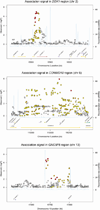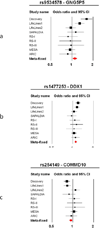Common genes underlying asthma and COPD? Genome-wide analysis on the Dutch hypothesis
- PMID: 24993907
- PMCID: PMC4217133
- DOI: 10.1183/09031936.00001914
Common genes underlying asthma and COPD? Genome-wide analysis on the Dutch hypothesis
Abstract
Asthma and chronic obstructive pulmonary disease (COPD) are thought to share a genetic background ("Dutch hypothesis"). We investigated whether asthma and COPD have common underlying genetic factors, performing genome-wide association studies for both asthma and COPD and combining the results in meta-analyses. Three loci showed potential involvement in both diseases: chr2p24.3, chr5q23.1 and chr13q14.2, containing DDX1, COMMD10 (both participating in the nuclear factor (NF) κβ pathway) and GNG5P5, respectively. Single nucleotide polymorphisms (SNPs) rs9534578 in GNG5P5 reached genome-wide significance after first replication phase (p=9.96×10(-9)). The second replication phase, in seven independent cohorts, provided no significant replication. Expression quantitative trait loci (eQTL) analysis in blood cells and lung tissue on the top 20 associated SNPs identified two SNPs in COMMD10 that influenced gene expression. Inflammatory processes differ in asthma and COPD and are mediated by NF-κβ, which could be driven by the same underlying genes, COMMD10 and DDX1. None of the SNPs reached genome-wide significance. Our eQTL studies support a functional role for two COMMD10 SNPs, since they influence gene expression in both blood cells and lung tissue. Our findings suggest that there is either no common genetic component in asthma and COPD or, alternatively, different environmental factors, e.g. lifestyle and occupation in different countries and continents, which may have obscured the genetic common contribution.
The content of this work is not subject to copyright. Designand branding are ©ERS 2014.
Figures







Similar articles
-
Childhood asthma is associated with COPD and known asthma variants in COPDGene: a genome-wide association study.Respir Res. 2018 Oct 29;19(1):209. doi: 10.1186/s12931-018-0890-0. Respir Res. 2018. PMID: 30373671 Free PMC article.
-
Ensemble genomic analysis in human lung tissue identifies novel genes for chronic obstructive pulmonary disease.Hum Genomics. 2018 Jan 15;12(1):1. doi: 10.1186/s40246-018-0132-z. Hum Genomics. 2018. PMID: 29335020 Free PMC article.
-
Susceptibility to corticosteroid-induced adrenal suppression: a genome-wide association study.Lancet Respir Med. 2018 Jun;6(6):442-450. doi: 10.1016/S2213-2600(18)30058-4. Epub 2018 Mar 15. Lancet Respir Med. 2018. PMID: 29551627 Free PMC article.
-
Genetic risk factors for the development of pulmonary disease identified by genome-wide association.Respirology. 2019 Mar;24(3):204-214. doi: 10.1111/resp.13436. Epub 2018 Nov 13. Respirology. 2019. PMID: 30421854 Review.
-
Genome-wide association studies: what do they teach us about asthma and chronic obstructive pulmonary disease?Proc Am Thorac Soc. 2009 Dec;6(8):701-3. doi: 10.1513/pats.200907-058DP. Proc Am Thorac Soc. 2009. PMID: 20008879 Review.
Cited by
-
COMMD10 inhibits tumor progression and induces apoptosis by blocking NF-κB signal and values up BCLC staging in predicting overall survival in hepatocellular carcinoma.Clin Transl Med. 2021 May;11(5):e403. doi: 10.1002/ctm2.403. Clin Transl Med. 2021. PMID: 34047468 Free PMC article.
-
Loss of the Drosophila melanogaster DEAD box protein Ddx1 leads to reduced size and aberrant gametogenesis.Dev Biol. 2015 Nov 15;407(2):232-45. doi: 10.1016/j.ydbio.2015.09.012. Epub 2015 Oct 1. Dev Biol. 2015. PMID: 26433063 Free PMC article.
-
Latrophilin receptors: novel bronchodilator targets in asthma.Thorax. 2017 Jan;72(1):74-82. doi: 10.1136/thoraxjnl-2015-207236. Epub 2016 Jun 20. Thorax. 2017. PMID: 27325752 Free PMC article.
-
Polymorphisms in the FCER2 gene have associations with asthma and chronic obstructive pulmonary disease.J Thorac Dis. 2023 Feb 28;15(2):589-599. doi: 10.21037/jtd-22-820. Epub 2023 Feb 6. J Thorac Dis. 2023. PMID: 36910110 Free PMC article.
-
Genetic regulation of gene expression of MIF family members in lung tissue.Sci Rep. 2020 Oct 12;10(1):16980. doi: 10.1038/s41598-020-74121-w. Sci Rep. 2020. PMID: 33046825 Free PMC article.
References
-
- Masoli M, Fabian D, Holt S, Beasley R. The global burden of asthma: executive summary of the GINA Dissemination Committee report. Allergy. 2004;59:469–478. - PubMed
-
- Beasley R. The Global Burden of Asthma Report, Global Initiative for Asthma (GINA) 2004
-
- Halbert RJ, Isonaka S, George D, Iqbal A. Interpreting COPD prevalence estimates: what is the true burden of disease? Chest. 2003;123:1684–1692. - PubMed
-
- Kraft M. Asthma and chronic obstructive pulmonary disease exhibit common origins in any country! Am J Respir Crit Care Med. 2006;174:238–240. - PubMed
-
- Plusa T. [Overlap syndrome--asthma and chronic obstructive pulmonary disease] Pneumonol Alergol Pol. 2011;79:351–356. - PubMed
MeSH terms
Grants and funding
LinkOut - more resources
Full Text Sources
Other Literature Sources
Medical
Miscellaneous
